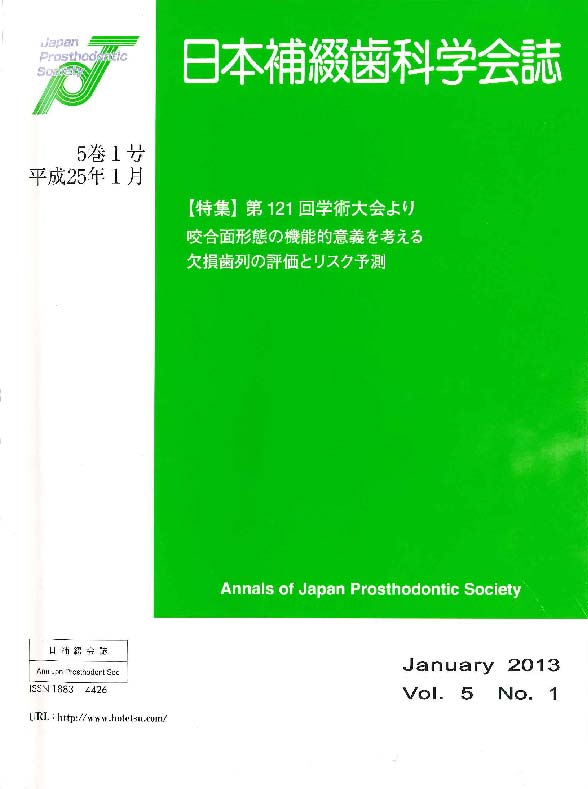Volume 5, Issue 2
The 121st Scientific Meeting of Japan Prosthodontic Society
Displaying 1-23 of 23 articles from this issue
- |<
- <
- 1
- >
- >|
Invited Articles
-
2013Volume 5Issue 2 Pages 119-120
Published: April 10, 2013
Released on J-STAGE: August 09, 2013
Download PDF (279K) -
2013Volume 5Issue 2 Pages 121-125
Published: April 10, 2013
Released on J-STAGE: August 09, 2013
Download PDF (569K) -
2013Volume 5Issue 2 Pages 126-129
Published: April 10, 2013
Released on J-STAGE: August 09, 2013
Download PDF (966K) -
2013Volume 5Issue 2 Pages 130-134
Published: April 10, 2013
Released on J-STAGE: August 09, 2013
Download PDF (924K)
-
2013Volume 5Issue 2 Pages 135-136
Published: April 10, 2013
Released on J-STAGE: August 09, 2013
Download PDF (269K) -
2013Volume 5Issue 2 Pages 137-140
Published: April 10, 2013
Released on J-STAGE: August 09, 2013
Download PDF (343K) -
2013Volume 5Issue 2 Pages 141-144
Published: April 10, 2013
Released on J-STAGE: August 09, 2013
Download PDF (673K) -
2013Volume 5Issue 2 Pages 145-148
Published: April 10, 2013
Released on J-STAGE: August 09, 2013
Download PDF (490K) -
2013Volume 5Issue 2 Pages 149-155
Published: April 10, 2013
Released on J-STAGE: August 09, 2013
Download PDF (717K)
Original Articles
-
2013Volume 5Issue 2 Pages 156-164
Published: April 10, 2013
Released on J-STAGE: August 09, 2013
Download PDF (602K) -
2013Volume 5Issue 2 Pages 165-173
Published: April 10, 2013
Released on J-STAGE: August 09, 2013
Download PDF (706K) -
2013Volume 5Issue 2 Pages 174-183
Published: April 10, 2013
Released on J-STAGE: August 09, 2013
Download PDF (710K)
Case Reports (Specialist)
-
2013Volume 5Issue 2 Pages 184-187
Published: April 10, 2013
Released on J-STAGE: August 09, 2013
Download PDF (868K) -
2013Volume 5Issue 2 Pages 188-191
Published: April 10, 2013
Released on J-STAGE: August 09, 2013
Download PDF (815K) -
2013Volume 5Issue 2 Pages 192-195
Published: April 10, 2013
Released on J-STAGE: August 09, 2013
Download PDF (578K) -
2013Volume 5Issue 2 Pages 196-199
Published: April 10, 2013
Released on J-STAGE: August 09, 2013
Download PDF (513K) -
2013Volume 5Issue 2 Pages 200-203
Published: April 10, 2013
Released on J-STAGE: August 09, 2013
Download PDF (579K) -
2013Volume 5Issue 2 Pages 204-207
Published: April 10, 2013
Released on J-STAGE: August 09, 2013
Download PDF (501K) -
2013Volume 5Issue 2 Pages 208-211
Published: April 10, 2013
Released on J-STAGE: August 09, 2013
Download PDF (1023K) -
2013Volume 5Issue 2 Pages 212-215
Published: April 10, 2013
Released on J-STAGE: August 09, 2013
Download PDF (528K) -
2013Volume 5Issue 2 Pages 216-219
Published: April 10, 2013
Released on J-STAGE: September 25, 2013
Download PDF (549K) -
2013Volume 5Issue 2 Pages 220-223
Published: April 10, 2013
Released on J-STAGE: September 25, 2013
Download PDF (603K)
Original Article (Secondary Publication)
-
2013Volume 5Issue 2 Pages 224-239
Published: July 10, 2013
Released on J-STAGE: September 25, 2013
Download PDF (1147K)
- |<
- <
- 1
- >
- >|
